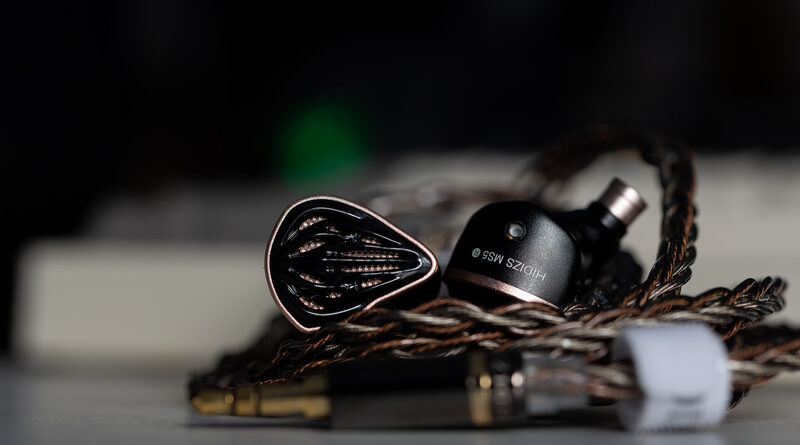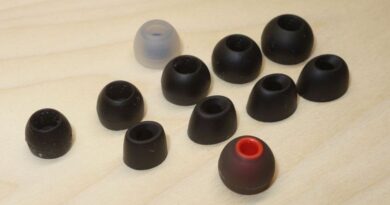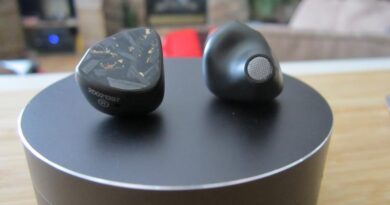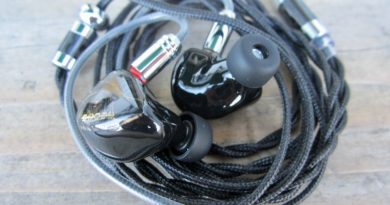Hidizs MS5 Review (3) – Living On The Edge
Pros — Excellent build
– High quality stock accessories
– Dense, fast, and punchy bass
– High-energy tuning suits certain genres and tastes
– Good macrodynamic punch and separation
Cons — Hidizs MS5 have thick nozzles that can compromise comfort
– 4.4mm balanced cable is a separate purchase
– Need more venting to avoid pressure buildup
– Recessed lower-mids
– Mircodynamics are barely perceptible
– Tuning can be too “in-your-face” at times
In this Article
INTRODUCTION
Hidizs is mostly known for the “source” products in its lineup, be it the dongles or the DAPs like AP80 Pro X. The IEMs released so far have been in the budget range and mostly tried to keep up with the competition rather than challenge them head-on.
The Hidizs MS5 aim to buck that trend. These are the most expensive IEMs Hidizs have ever produced. Heck, if memory serves right (and looking at their current lineup), the MS5 are the most expensive product Hidizs has ever launched.
This heightened price tag brings forth elevated expectations. Do the Hidizs MS5 showcase a performance that befits the price, or do they fall short of the high bar? Let’s find out.
Note: the ratings given will be subjective to the price tier. Hidizs was kind enough to send me the MS5 for evaluation.
Sources used: Questyle CMA Twelve Master.
Price, while reviewed: USD$400. Can be bought from Hidizs.
PHYSICAL THINGS AND USABILITY
PACKAGING AND ACCESSORIES
Hidizs managed to make their flagship packaging look the part. While the box has no fancy layers like some manufacturers do, it is chock full of high quality accessories. You get the IEMs themselves, 9 pairs of eartips, two pairs of extra tuning filters, an 8-core cable, and a large carrying case.
The stock cable is very good – flexible/pliable and doesn’t tangle easily. It’s a single-crystal copper and silver-plated copper hybrid. The earhooks are on the stiffer side and I am not a fan of the strange design Hidizs picked for the 2-pin housing.
The stock tips form a good seal, and I found the balanced tips to go well with the stock tuning. The stem is hard though, so those with small ear canals might require tip-rolling for better comfort. The carrying case has ample room to fit the IEMs with the cable alongside the tuning filters. This makes the case too large to put in the pocket, however.
All in all, Hidizs did not skimp on the accessories, but I would have preferred the option to select 4.4mm balanced cable as “stock cable” during purchase. As of now it’s a separate accessory and this should not be the case.
BUILD QUALITY
The 3D-printed, UV-cured resin shells of the Orchestra Lite have good consistency and give a dense feeling in the hand. There are some refractions inside the shells though some may consider them a design element. Nonetheless, overall shell quality is similar to Moondrop’s Blessing2, if not at a slightly higher level.
The backplate evokes a sense of depth, though the artwork itself is somewhat generic. There are no vents on the shell, making this a completely sealed design.
The nozzle has three bores, one for each frequency band (bass, mids, treble). More on this later. Unfortunately, the large size makes it difficult to fit some tips.
Finally, the flush 2-pin ports complete the build tour (I prefer them recessed though). In short: Hidizs has managed to create a striking design that makes the MS5 instantly recognizable.
COMFORT, ISOLATION, AND FIT
Comfort is average due to the large nozzle size. Moreover, the singular vent is not enough to alleviate the pressure buildup, and a tight seal creates some discomfort. .
SOURCE AND EARTIPS
The Hidizs MS5 are very easy to power, a bit too easy some would say due to the ultra-low 5.3 ohms impedance. Reality is that these are source-picky IEMs. They demand a source with very low output impedance (below 0.5ohms) and the noise floor also has to be low to not pick up any hiss.
As for tips, I used the stock “balanced” tips and they provided adequate seal.
DRIVER SETUP
Hidizs goes for a five driver hybrid setup, with 1 dynamic driver + 4 balanced armature drivers arranged in a 3-way crossover design. The single DD (kevlar dome + silicone surround) and a Sonion 17A003 is in charge of the lows and lower-mids respectively, a and a pair of “composite” Sonion E50DT as super-tweeters for ultra-high frequencies.
There is also the “nozzle-based” tuning option where you can replace the stock nozzle with one of the supplied ones and they dampen (or increase) the treble, resulting in a heightened or lower sense of bass respectively. I ended up using the default balanced nozzle since the other two sounded too bloated (bass nozzle) or too brittle (treble nozzle).
TONALITY AND TECHNICALITIES
Hidizs MS5 have a highly energetic V-shaped tuning with some extra sizzle up top.
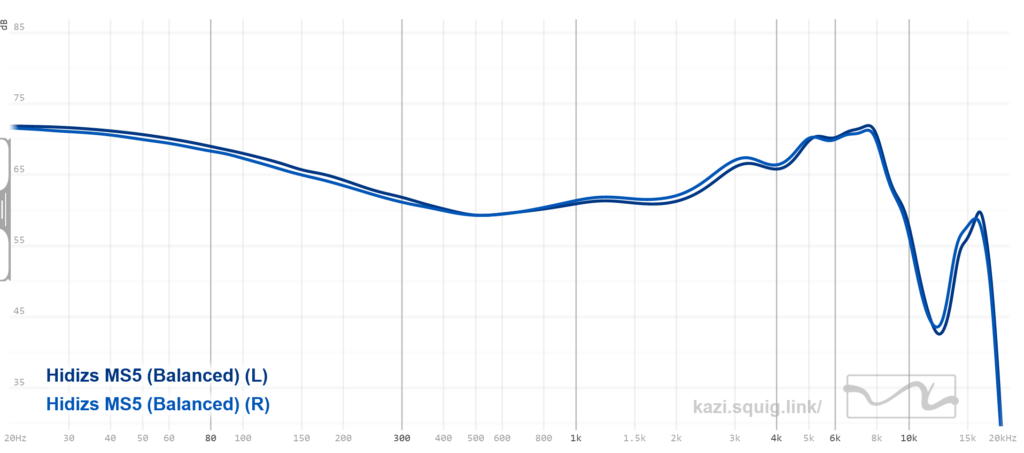
The most impressive aspect of the MS5 has to be the bass response. It’s fast, punchy, and slams hard. After a series of IEMs with disappointing bass, the MS5 buck that trend fairly well. However, the bass can get too fast at times, with some decaying notes being overshadowed by the leading edge of the next note. This also hurts bass texture a bit, missing some of that “organicness” associated with the best dynamic drivers out there. However, it’s a minor sacrifice to make for an otherwise excellent bass response.
Mids are a mixed bag. The lower mids have good body and density but sit behind the bass and treble in the mix. This results in a loss of “focus” when it comes to male vocals, and the transition from lower midrange to upper midrange is handled abruptly. There is some hollowness between 1.5-3kHz, which adds some chestiness to soaring male vocals.
The mids don’t sound overly shouty, shrill, or thin though, so there’s that. Acoustic guitars sound a bit blunted, with the low notes getting more focus. Guitar riffs are in the background when cymbals are also playing around the same volume but this helps in reigning in what could be “aggressiveness overload”.
Finally, we get to the treble which is the most polarizing aspect of the Hidizs MS5. It is noticeably elevated, putting cymbals and hi-hats in added focus. There is a lot of energy in the sound, which may get too much at times. Those who prefer high-energy tuning will find the MS5 right up their alley. It’s a bit too much for my tastes, however. Adding some dip around 6kHz via EQ helps in smoothing out the signature, so try that out if you want less fatigue in the tuning.
Soundstage is strange. It doesn’t sound cramped but the depth is not well rendered. Stage height is good though. Imaging is good when it comes to cardinal positioning, but center imaging suffers as things sound in your head instead of projected to the front..
Macrodynamic punch is very good, while microdynamics are lacking. General resolution is good even though most of it can be attributed to the extra-sizzly treble response.
SELECT COMPARISONS
vs Moondrop Blessing2 Dusk
Moondrop Blessing2 Dusk have been out in the market for a while and Moondrop recently released the updated model in Blessing3. As I have not heard the updated model, I’d mostly compare with the ageing B2 Dusk.
In terms of build and accessories, the MS5 win hands down. Comfort is a question mark on both of these IEMs. Isolation is slightly better on the MS5 though, and they sport the tuning mechanism even though it makes little difference to me.
As for the sound, the Blessing2 Dusk go for a more neutral, analytical tuning vs the bombastic, high energy MS5 tuning. The bass is noticeably faster and slams harder on the MS5, while the B2 Dusk opts for a nimbler, more lightweight bass response. This lighter bass rendition meshes well with the mids of the B2 Dusk which is slightly thinner/colder than the MS5 while being more upfront. Treble is not as aggressive on the B2 Dusk, sacrificing treble forwardness for airiness.
In the end, I find the B2 Dusk more suited for those who prefer a somewhat neutral tone without completely sacrificing bass punch. The mids are thinner but the rest of the frequencies are fairly balanced. The MS5 have a more colored presentation that works well with some genres (Pop, Rock, Hip-hop) while sounding too forward in fast-paced metal tracks.
CONCLUDING REMARKS
Hidizs broke the price barrier with the MS5, and their marketing push indicates that the brand has a lot riding on the success of the MS5.
I’d say the MS5 are living on the edge: a bit further and they become too aggressive, a few steps back and they become too unremarkable. It’s not the most comfortable position to be in, but the MS5 manage to toe the line.
There is no denying that Hidizs’ choice of tuning here will be polarizing, but that also means those who like such high energy presentation will find only the MS5 as a suitable purchase option. Only Sennheiser IE 300 offer a similar tuning in the <USD$500 bracket and they fall behind in terms of technicalities.
So the MS5 are not something I’d recommend as an all-rounder, rather they are for the moments when you need that extra dose of treble and bass. I expect more refinement on the tuning front, however, and I hope Hidizs controls the treble better in the next release to make their offerings more universally appealing.
DISCLAIMER
Get it from Hidizs.
Our generic standard disclaimer.
You find an INDEX of our most relevant technical articles HERE.



